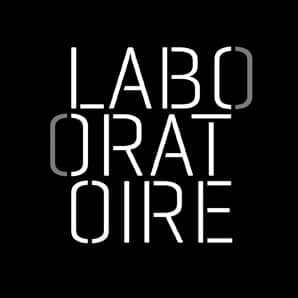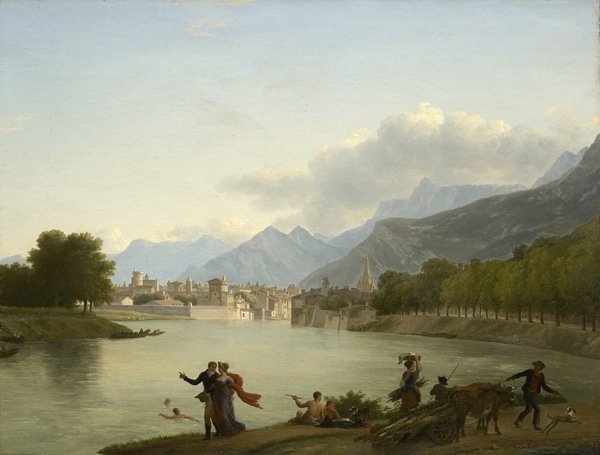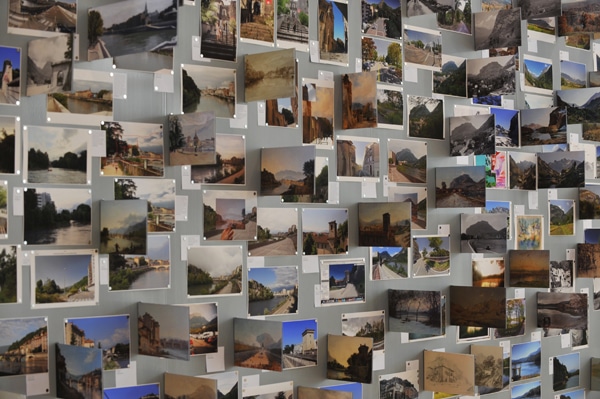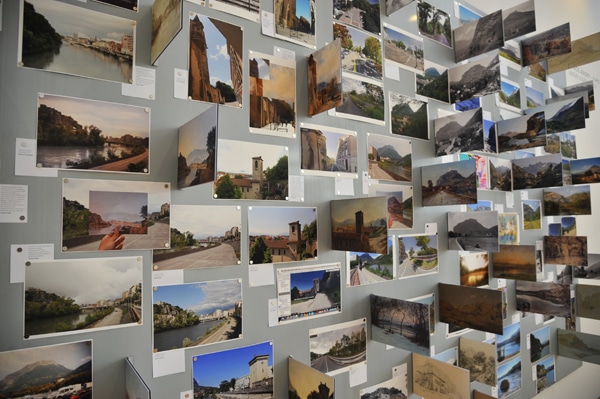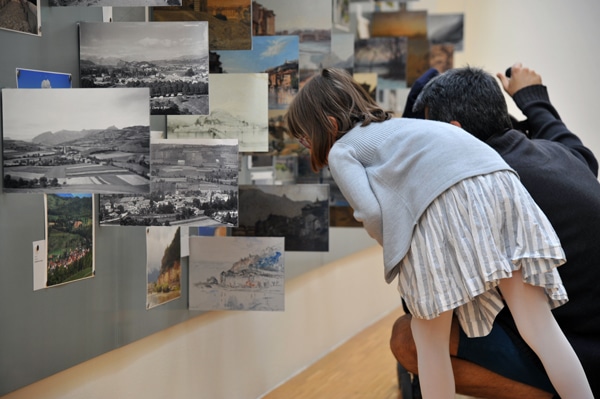Where was the artist when he painted or photographed this landscape? This is the enigma that invites you to solve a game posted on the site www.paysages-in-situ.net, or available free by downloading the landscape-in-situ application compatible with all types of smartphones. This game proposes to choose one of some 300 paintings and photographs of landscapes of the Isère from the collections of the Museum of Grenoble, the Hebert Museum of La Tronche, the Dauphinois museum and the library of studies of Grenoble. It consists in finding the exact position where the artist was when he painted or photographed this landscape, and invites you to realize from this point of view a replica in photography or drawing or with digital mapping software such as Street view.
The best interpretations are exhibited during the Journées du Patrimoine from September 19, 2015 to January 18, 2016, at the Musée de Grenoble and the Musée Hébert de La Tronche. Then in the fall of 2016, benches will be installed on each of these geolocalized sites thanks to your answers, the landscape-in-situ application will allow you to understand the approach of the artists and to discover the replicas of all the participants.
How to refine our perceptions?
Everything seems clear and limpid in the landscape, and yet everything is strange in this notion when one dwells on it. The landscape is no longer regarded today as it was formerly regarded, when the majority of the individuals were laborers of the land, pastors or laborers, or even more recently when our daily relationship with the outside world was not yet so frequently transited through The computer screen or mobile phone.
This word “landscape” appeared late in the main European languages and at about the same time (around 1510), as if for a very long time the women and men who inhabited and practiced the territory before us had not felt the need To name this distant region. The word was used for the first time in Europe several years after the appearance of the first landscape paintings (made around 1495), and the word “landscape” first translated a painted representation before becoming a “portion of nature Which is offered to the viewer of the observer, “according to the definition of the dictionary Le Robert. This definition is also strange because it presupposes the exteriority of the viewer, that is, the face-to-face contact between nature offered, and an observer removed from the landscape, on which he brings a point of view, Which he observes without writing. Are we so sure not to be enrolled in the ecosystem of the environment that we observe?
Landscapes-in-situ (Paysages-in-situ) tries to sharpen our individual attention to the landscape, and to refine our collective perceptions by exchanging them, comparing those of one with those of others – tireless walkers or contemplatives posted at the window, Tourists of passage, native of here or heirs of other landscapes, mushroom pickers or photographers …. It is a question, in a way, of contributing by playing to make each one of us virtuoso in landscape.
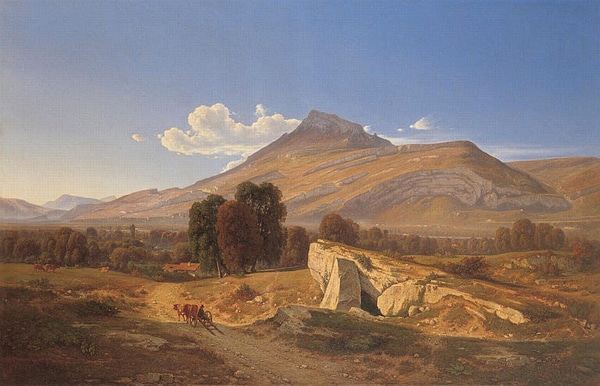
View taken in Saint-Egrève, near Grenoble, Jean Achard, 1884, oil on canvas 147 x 229 cm (collection Museum of Grenoble)
Process Overview:
Landscapes-in-situ (Paysages-in-situ) is a game within reach of everyone and offered to all – tireless walkers or contemplatives posted at the window, long-time residents or tourists of passage, native here or heirs of other landscapes, mushroom pickers or Photographers ….
Paysages-in-situ is an invitation to discover, observe and compare the works preserved in the museums of the Grenoble region, then to locate them by going to check in the real landscape the location where the artist was, there Is 150 years old, when everything has changed in this environment and which the painter had undoubtedly already sorted and composed at the time between the beautiful and the ugly, the luminous and the chiaroscuro, the fragile and the grotesque.
Surroundings 200 paintings and 100 old photographs on glass plates make up this landscape game. They are fairly rarely presented to the public (only 10% of the selected works come from permanent exhibitions). These are works from the collections of the Grenoble Museum, the Hébert Museum, the Musée Dauphinois, or the Bibliothèque de Grenoble, representing landscapes belonging to our nearby Alpine territory.
This landscape game invites everyone to compose a replica of the original view using all the tools available, from the newest ones, such as those of digital mapping, to the more classic ones such as pencil or photography. We are not so far from the copies executed by the amateurs in the museums of the end of the XIX century. But where the copying approach is lived today as a discipline, our proposal to interpret the landscape using all the tools available allows us to associate without reservation all the audiences, that of video games, Social networks, synthetic imagery, digital cartography, photography, drawing, writing …. This pragmatic choice makes it possible to cross the aesthetics by creating dynamic tensions.
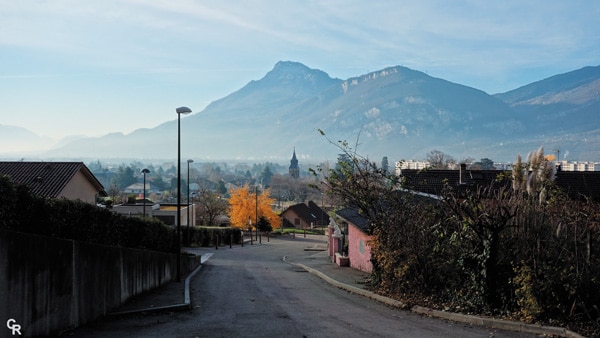
Replica of Jean Achard’s painting (1884) by Christian Rau situating the site at 45,245 latitude and 5,686 longitude)
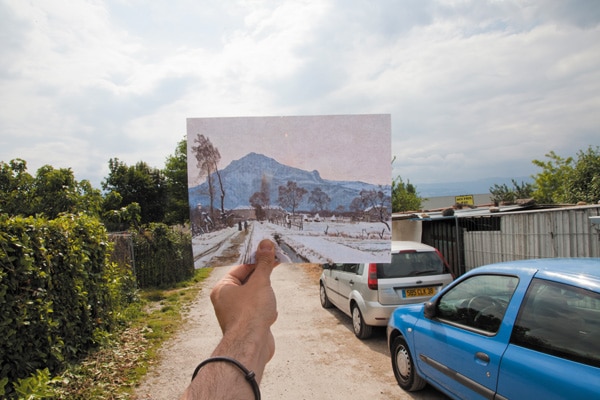
(Replica of Ernest Victor Hareux’s original oil (1892) by Andréa Bosio situating the site at 45,182 latitude and 5,774 longitude)
Paysages-in-situ offers to everyone to publicly expose its answer, during a double exhibition from September 17, 2015 to January 18, 2016, at the Musée de Grenoble and the Musée Hébert.
Then in the autumn of 2016 everyone will be able to sit on a bench implanted very precisely thanks to the quality of the localities resulting from the collaborative process and will be able to consult on his tablet or on his phone all the information available on this work and to discover the replicas Invented by the participants.
We can imagine situations where the bench will find its place easily in the site, favoring the back and forth between the past and the present, between the landscape seized in the original work and the landscape of today. But it is likely that some sites will turn out so upset that the physical inscription of a bench at this particular location will appear strange, incongruous, or will simply be impossible. This hazard will open a new dynamic space of collective reflection on the contemporary condition of our everyday environment.
Paysages-in-situ is a proposal of the Laboratory, produced in partnership with> the Grenoble Museum> the Dauphinois Museum> the Hebert Museum> the Grenoble Municipal Library> the Old Bishop’s Museum, the House of Nature and The Environment> Grenoble Office of Tourism> the CAUE of Isère> the Méliès> the CNRS-PACTE Research Laboratory> the National Education (DSDEN of the Isère and DAAC). In a media partnership with the Dauphiné Libéré, the Petit-Bulletin and France 3 Alpes.
Landscapes-in-situ, a device for popular innovations around landscapes, is carried out with the support of> the Rhône-Alpes region> of Grenoble-Alpes-Métropole> of the Department of Isère> of the city of Grenoble> Culture and Communication, within the framework of calls for innovative digital cultural projects> of the House of Human Sciences-Alps, under its program 2015 on the digital humanities> UMR LITT & Université Grenoble-Alpes and CNRS under the AGIR-PEPS program “Media Ecology”.
